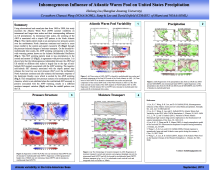Inhomogeneous influence of the Atlantic warm pool on United States precipitation
Hailong
Liu
Institite of Oceanography Shanghai Jiaotong University
Poster
On interannual time scales, the warming of the Atlantic warm pool (AWP) is associated with a tripole sea surface temperature (SST) pattern in the North Atlantic and leads to more rainfall in the central and eastern US. On decadal-to-multidecadal time scales, the AWP warming corresponds to a basin-wide warming pattern and results in less precipitation in the central and eastern US. The inhomogeneous relationship between the AWP warming and US rainfall on different time scales is largely due to the sign of mid-latitude SST anomaly. The negative mid-latitude SST anomaly associated with the tripole pattern may enhance the low sea level pressure over the northeastern North American continent and also enhance the barotropic response there of the AWP-induced barotropic Rossby wave. This strengthened low pressure system, which is not exhibited when the warming is basin-wide, results in a different moisture transport variation and thus the rainfall pattern over the United States.

Poster 20.pdf
(149.88 KB)
Session III: Weather and climate extremes in the Americas

Number of comments: 6
Comments
Comment by: Brian Mapes
August 31, 2015 - 12:44pm
There is no "view poster" button on this one -- Aug 31
Comment by: Brian Mapes
August 31, 2015 - 12:53pm
Does this imply that climate research could be more fruitful, or more understandable, when cast in the Eulerian space of SST patterns (for example, EOFxPC pairs)? From that viewpoint, perhaps the AWP (area exceeding an arbitrary fixed value) is a peculiar, inconvenient mixture of the more fundamentally real "modes" of variability. Is that the interpretation that is implied here?
Or do you consider the AWP a meaningfully fundamental entity, perhaps in solely oceanographic terms, which then needs translation through the space of patterns or modes that it happens to project onto?
Comment by: Hailong
September 11, 2015 - 2:34am
Hi Brian, sorry for late reply as I am in the process of settling down. Yeah, I think the Eulerian space of SST patterns does play a role in regulating air-sea interaction which contribute to the climate. However, it is still not fully understood for the air-sea interaction in the mid and high latitudes. So further research using numerical experiments is needed to strengthen the conclusion.
For the definition of the AWP, I still consider it a meaningfully fundamental entity. Though the variability of the AWP can be projected onto major modes of variability cause it is a part of the tropical Atlantic, the definition of the AWP has its own uniqueness in describing the local ocean state and addressing the impacts of the ocean such as on tropical cyclones when the extratropical influences are not significant.
Comment by: kuhlenbrock
September 1, 2015 - 7:08am
Hi Brian-
Hailong Liu has not uploaded a poster, yet. Hopefully this will happen soon.
Comment by: Vasu Misra
September 2, 2015 - 3:14pm
Hi Hailong,
Nice work. The barotropic response to AWP warming is actually a wave train of H L H from the southern US across to northwest Atlantic. So at interannual scales the common signal of precipitation anomalies related to AWP anomalies is of opposite sign between south-central US and northeast US. But from your figures it seems like the precipitation anomalies in central and eastern US are of similar sign?
Comment by: Hailong
September 11, 2015 - 3:08am
Hi Vasu, so sorry for late reply. It is not convenient to get the access to the internet these several days. Yeah, the precipitation anomalies in central and eastern US of this study roughly have the same sign. one explanation is that the convergence pattern of moisture transport doesn't follow the wave train due to extratropical influences. Also the historical data used in this study is not elaborative. We are performing a further study based on numerical experiments.
Not accepting new comments